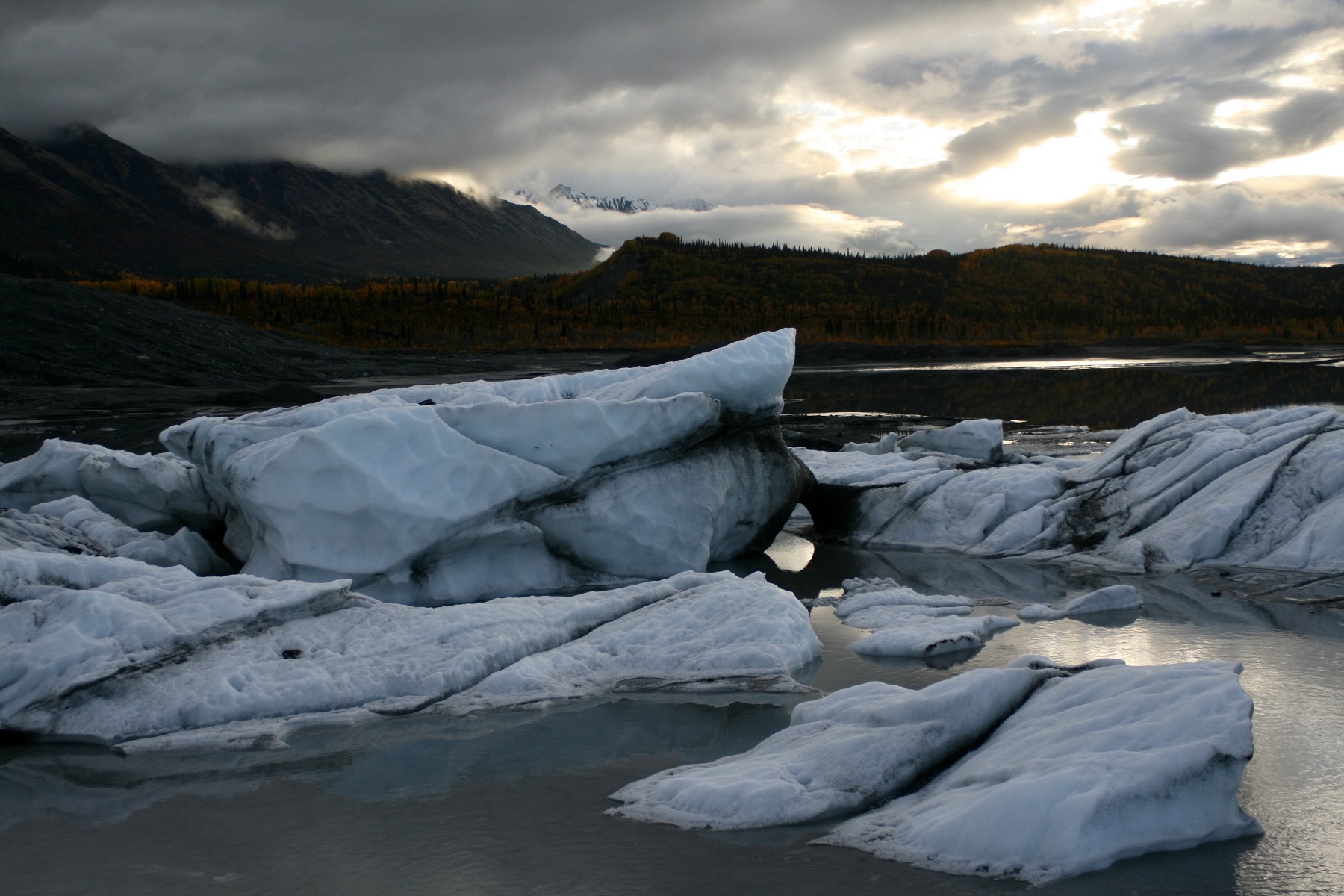Matanuska Glacier Over Time

A Natural History
During the last glacial maximum, about 22,000 years ago, the Matanuska Glacier reached its peak in size. The terminus once reached the north end of Anchorage. The Knik Glacier met with the Matanuska and formed a lobed shape during this time period. Geological evidence points to these two glaciers retreating in two separate phases.
Glacial ablation occurred through stagnation with the Matanuska. This is to say that the glacier was melting faster than it could form. After the second faster phase of melt, about 13,700 years ago, the glacier downwasted. Downwasting is a thinning of a glacier ice due to melt, similar to the size we know it as today.
Once these two segments began, the world’s glacial systems went under dramatic retreat. Since that last period the Matanuska Glacier has not changed as dramatically. When you drive down the Glenn Highway into the Mat-Su Valley there are many indicators of past glaciation.
As you wind down the highway you can see etched shelving in the sedimentary rock. And, spot glacial striations across nearby igneous rock. The Matanuska River sits in the bottom of the valley, braiding through highly erosive sediment. The river sides provide an example of how the glacial melt continues to shape the valley.
If you were to take a raft ride down the river you would would be able to look up to the giant sheered cliffs. These cliffs are evidence of ice that was previously taller by hundreds of feet. Ice once so dense and strong, pushing grooves into the valley, and taking off whole walls of mountain sides by force.
As the river winds from Caribou Creek, raging rapids sit at the base of a sharp facet of rock. This is the southeast face of Lion’s Head. Lion’s Head is a volcanic plug that at one point was in the glaciers moving pathway. The after math of the glaciers’ great force is the blunt side wall of Lion’s Head.
The Matanuska Now
The Matanuska Glacier as we know it today is approximately a 27 mile long and four mile wide valley glacier. This slow moving river of ice spills between the peaks of Mt. Marcus Baker and Mt. Wickersham carving away a section of the Chugach Mountains. Snow accumulates at the base of these peaks turning into a granular intermediate substance (Névé) between snow and ice.
Through the freezing and melting stages of the glacier, the basal layer of ice (the bottom most layer) slowly grinds into the valley floor and walls. With the help of growing ice weight and gravity, the glacier slowly fills into the land. This changes the geography of the terrain by carving through weight and force of the ice.

Matanuska Glacier Ice Fall 2015 Photo Credit: Roz
The glacier is downwasting at about one foot per year. During the melting seasons the glacier can increase in speed by hydroplaning on a layer of water that forms under the ground ice. As ice melts, water follows the most available and least resistant pathway. Water tunnels into weaker ice layers creating moulins.
Water moves through these weak layers to pour from glacial openings called vents or off the end (toe) of the glacier and into the Matanuska River. These melting changes also influence crevasse openings. Crevasse is the french term for the large cracks in the ice that often appear blue.
The Chugach mountains and the valley floor are being ground and scraped as the glacier moves and the ice continues to break down the rocky material, eventually finding its way to become moraine. As the glacier moves down the landscape, the ice is met with obstructions or cliff like drops of the valley floor.
These unseen features below the ice are given away by what is happening on the surface layer that we can observe, an ice fall. As this river of ice hits the obstruction, it slowly peels over itself, as if it were a waterfall frozen in time. The cross sections of crevasses then create giant fins called seracs, another french term. The best way to spot these is by taking a quick flight and exploring with a guide.
During the melt season you will find a large glacial lake at the bottom of the ice fall at the end of the glacier. This lake is fed by the glacial melt and rises, drops, and stagnates as the temperatures change. This melt eventually outlets and confluences with the Matanuska River. The melt water is constantly being stirred with glacial silt and rock as it appears in different shades of grey. The shade of grey is dependent on how much water, how fast, and how much sediment is currently present.
Over the Years

Matanuska Glacier Ice Fall 2019 Photo Credit: Roz
For decades people have been exploring this roadside glacier and stacking up their stories of experiences. First hand accounts from glacier guides and locals tell the tale of decades past and how the glacier is changing in our lifetimes. The pictures show the foot per year of surface ice melting. This downwasting is reducing the height of the glacier, increasing the size of the glacial lake, and leaving a larger expanse of rocky moraine at the toe of the glacier.
Where beaming white ice once lined the pathway to the fall, now is blanketed with rocky moraine and dirt cones. Climbers previously scaled giant walls adjacent to the ice fall. These walls are now much smaller mounds of ice. The glacial lake has grown in size as water flows over the thinning ice underneath. Sometimes, water currents cut large chunks of ice free to float on as icebergs. Over the last five years this has been documented photographically.
Glacial Changes
Globally there is a vast amount of documentation on the current events of glacial recessions. Many times we see videos of giant glacial cavings of tidal ice and we may ask ourselves ‘how is the Matanuska only losing a foot of ice per year?’ Seems like a stark contrast to the massive losses we see on the Alaskan coast lines.
NASA has recorded some excellent images over the last 50 years by satellite, as the video below shows.
Valley and alpine glaciers undergo recession by melting at a faster rate than the glacier can form. This can happen in a variety of ways but takes much longer than that of a tidal glacier. Tidal glaciers are not only fighting melting rates, but also rising sea levels that increase that rate and amount of recession. In conclusion, valley and alpine glaciers are receding or downwasting at a much slower rate. Simultaneously, we can see the changes in glacier ice with our eyes and recordings during our lifetimes.
